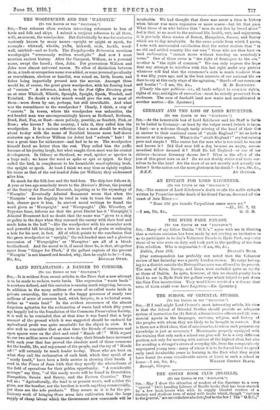THE WOODPECKER AND THE WARSPITE: [To THE EDITOR OF THE
" SPECTATOR."] Sra,—Your columns often contain interesting references to lore of birds and folk and ships. I submit a conjoint reference to all three, with, as cement, the woodpecker. But dialectically he was for centuries variously known by many names—,speight or spight or speck, for example : whitwall, whetile, yaffie, hickwell, cede, hackle, wood. wall, raiubird—and so forth. The Encydopudia Britannica mentions woodspeight "erroneously written woodepite." And now I must mention ancient history. After the Conquest, William, as a personal name, swept the board ; then, John. For generations William and John were almost universal names. To allow of distinction between them, a trade or occupation name was added, or some personal peculiarity or resemblance, obvious or fanciful, was seized on, birds, beasts, and fishes being impartially pressed into the service. Amongst these would be, of course, the great green woodpecker, with his flaming head of "carrots." A reference, indeed, to the Post Office Directory gives us at once Whitten, Whittle, Speaight, Speight, Speck, Woodall, and Rainbird. No doubt a wider search would give the rest, or most of them—worn down by use, perhaps, but still identifiable. And what was the resemblance to tho woodpecker Clearly, I think, a crop of " carrots." In towns, where the woodpecker was unfamiliar, the red-headed man was uncompromisingly known as Redhead, Redman, Reed, Rud, Fox, or Rust—more politely, possibly, as Scarlett, Pink, or Rose ; who knows ? In the country, I take it, they called him the woodpecker. It is a curious reflection that a man should be walking about to-day with the name of Rainbird because some half-dozen centuries ago a forebear William (or John) had " auburn " hair ! It was a great time for nicknames—and had to be so. The .woodpecker himself fared no better than the rest. They called him the yaffie because of his jeering laugh, but what canght them most was his cranial development. In Orkney or Shetland, we read, spieker or specker is a largo nail ; we know the word as spike or spit or spigot. So they called the bird, in compliment to his formidable wood-splitting beak, the speight or speck. At least I think we may thus as rightly explain his name as that of the red-headed John (or William) they nicknamed after him.
So much for the folk-lore and the bird-lore. The ship-lore follows it. A year or two ago somebody wrote to the Mariner's Mirror, the journal of tho Society for Nautical Research, inquiring as to the etymology of Warapite: Eventually Admiral Beaumont wrote that when the ' Warapite ' was his flagship he tried in vain to trace the name. At last, chance gave it him. In ancient naval writings he found the word given as Warspeight ' and Warspeaght.' (Mr. Wheatley, of Pepysian fame, informs me that the great Diarist has it Warspight2) Admiral Beaumont had no doubt that the name was "given to a ship or galley in the days when they rammed the enemy with their beak and made holes in the hull "—like the woodpecker with his muscular neck and powerful bill breaking into a tree in search of grubs or enlarging a hole for his nest, in fact. All of which points to the conclusion that the green woodpecker or " speight," the red-headed man and a glorious succession of Warspeights ' or Warspites ' are all of a blood. brotherhood. And the moral to it, if moral there be, is that, altogether apart from "Ginger for Pluck," if the gallant captain of the present Warspite ' is not himself red-headed, why, then he ought to be !—I am,


































 Previous page
Previous page